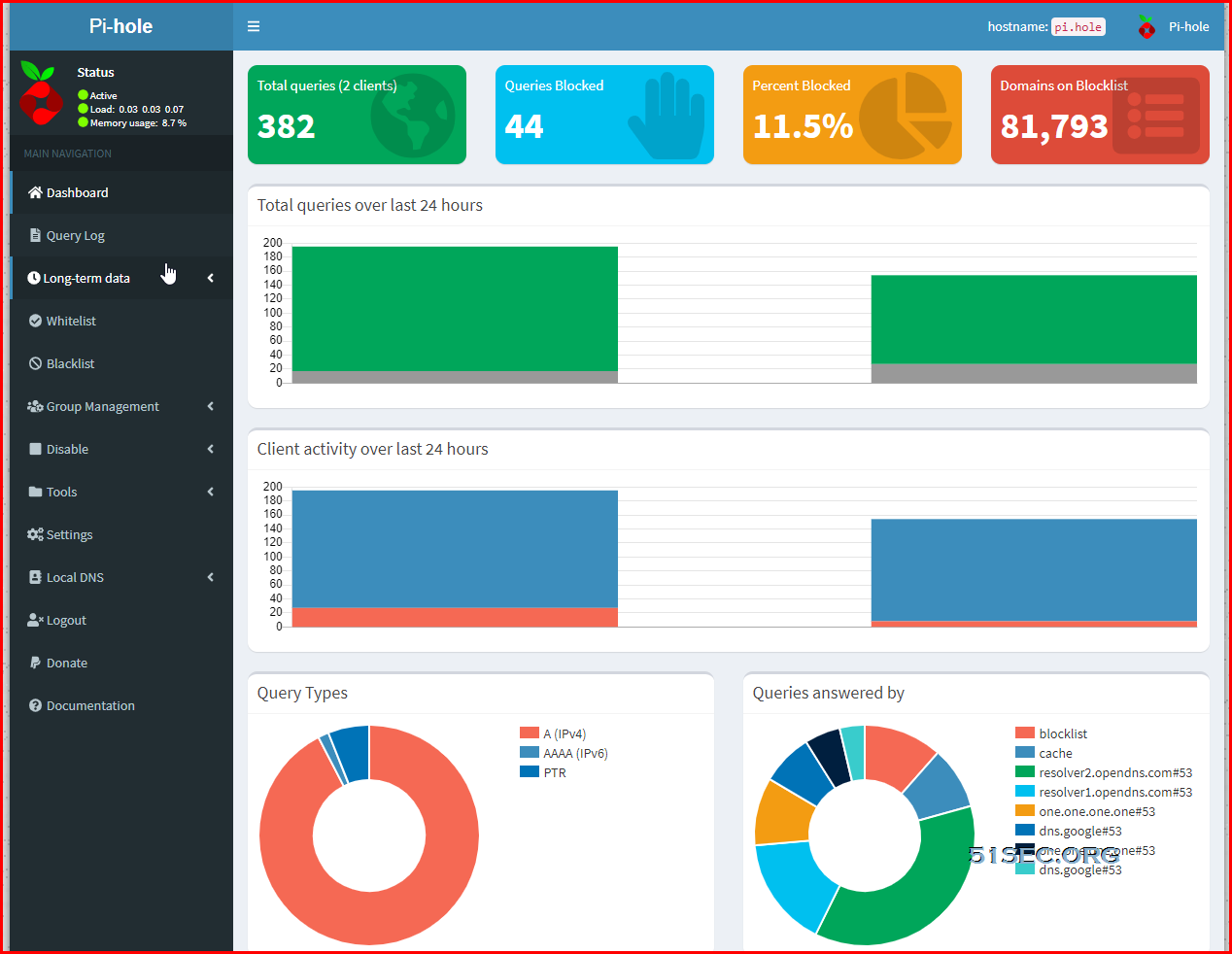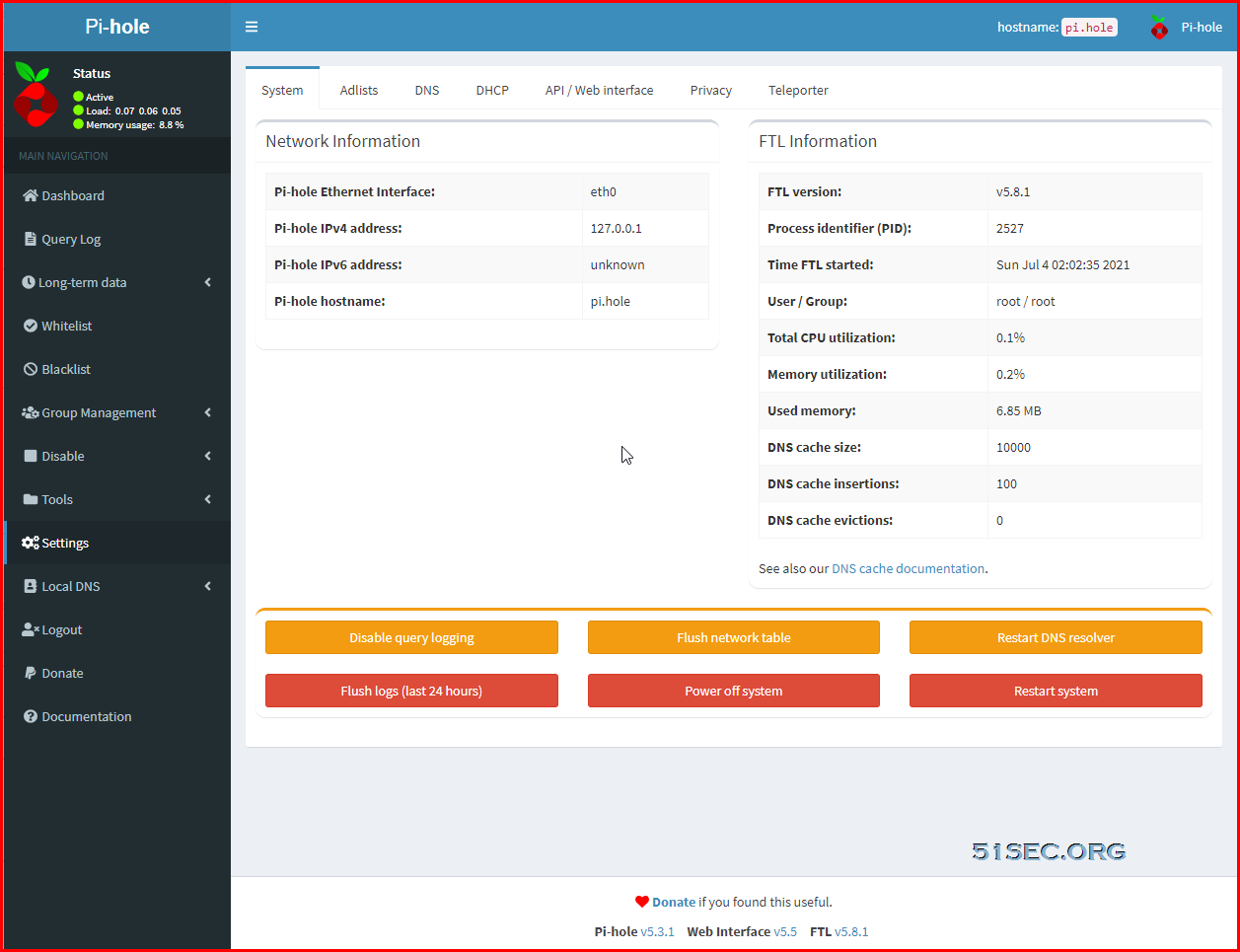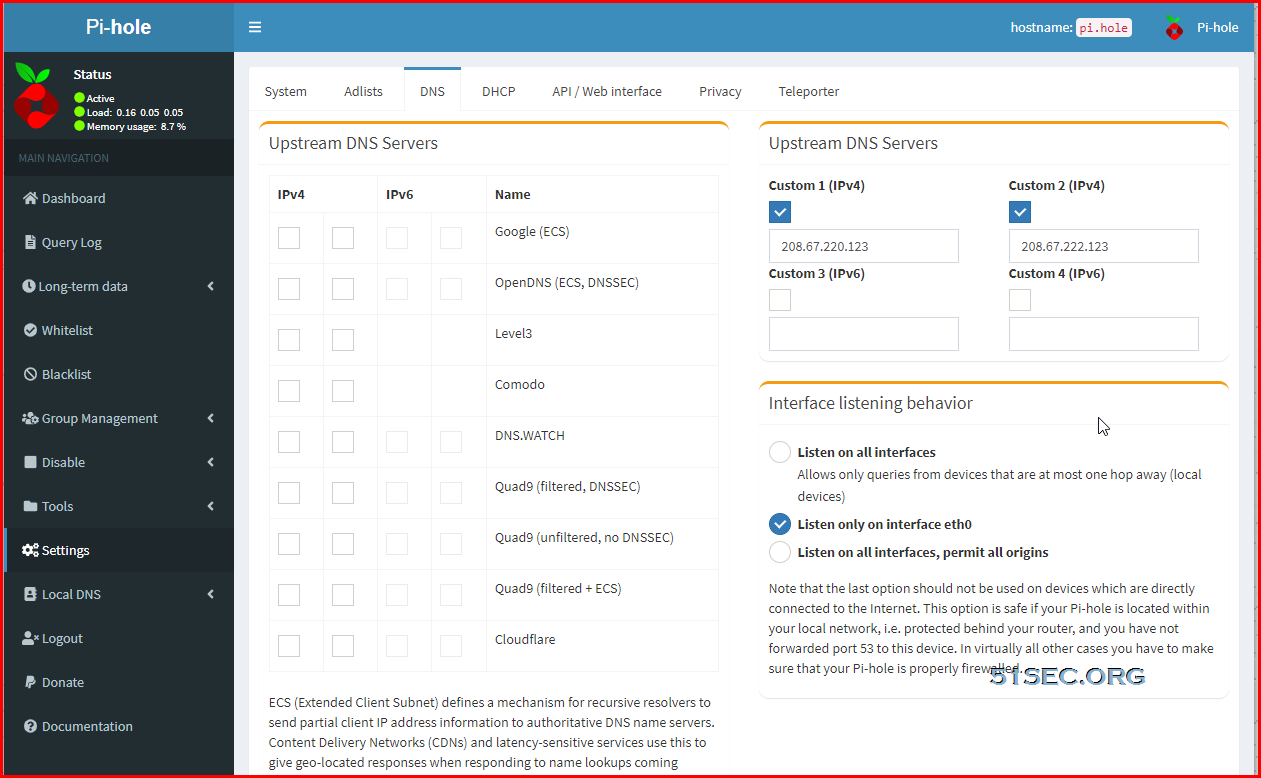Pi-hole or Pihole is a Linux network-level advertisement and Internet tracker blocking application[2][3][4][5] which acts as a DNS sinkhole[6] and optionally a DHCP server, intended for use on a private network.[1] It is designed for low-power embedded devices with network capability, such as the Raspberry Pi,[3][7] but supports any Linux machines.[6][8][9][10]
Pi-hole has the ability to block traditional website advertisements as well as advertisements in unconventional places, such as smart TVs and mobile operating system advertisements.[
– from Wikipedia
In this post, I summarized all necessary steps to set up my home Pi-hole server.
Set up Static IP :
root@hpthin:~# cat /etc/netplan/00-installer-config.yaml
# This is the network config written by 'subiquity'
network:
ethernets:
enp5s0:
addresses: [192.168.2.8/24]
gateway4: 192.168.2.1
nameservers:
addresses: [8.8.8.8, 1.1.1.1]
version: 2
root@hpthin:~#
When editing Yaml files, make sure you follow the YAML code indent standards. If the syntax is not correct, the changes will not be applied.
Once done, save the file and apply the changes by running the following command:
sudo netplan applyUpdate Ubuntu 20.04 8system to latest:
[root@OCP1-Ubuntu ~]# apt upgrade -y && apt update -y
Install Docker, Docker-Compose and Portainer
Install Docker on Ubuntu 20.04:
#Ubuntu 20.04
sudo apt install docker.io
#Ubuntu 20.04
sudo apt install docker-compose
[root@ubuntu20 ~]# docker volume create portainer_data
portainer_data
[root@ubuntu20 ~]# docker run -d -p 9000:9000 --name portainer --restart always -v /var/run/docker.sock:/var/run/docker.sock -v portainer_data:/data portainer/portainer-ce:latest
Unable to find image 'portainer/portainer-ce:latest' locally
latest: Pulling from portainer/portainer-ce
94cfa856b2b1: Pull complete
49d59ee0881a: Pull complete
f220caeff793: Pull complete
Digest: sha256:67e3edef02ba465d18663cd273cc24ec2764b27686ea5afbe8f392317a70ed72
Status: Downloaded newer image for portainer/portainer-ce:latest
d0ff883b063156b5929a8999593d38837501e6c16ffcefcbefb221ebe0301a32
[root@ubuntu20 ~]#
Free Up Port 53, Used By systemd-resolved
$ sudo lsof -i :53
COMMAND PID USER FD TYPE DEVICE SIZE/OFF NODE NAME
systemd-r 610 systemd-resolve 12u IPv4 19377 0t0 UDP localhost:domain
systemd-r 610 systemd-resolve 13u IPv4 19378 0t0 TCP localhost:domain (LISTEN)
1. Edit
/etc/systemd/resolved.conf with a text editor (as root), e.g. open it with Nano console text editor:sudo nano /etc/systemd/resolved.conf
[Resolve]
DNS=
#FallbackDNS=
#Domains=
#LLMNR=no
#MulticastDNS=no
#DNSSEC=no
#DNSOverTLS=no
#Cache=no
DNSStubListener=no
#ReadEtcHosts=yes
/run/systemd/resolve/resolv.conf with /etc/resolv.conf as the destination:sudo ln -sf /run/systemd/resolve/resolv.conf /etc/resolv.conf
-s is for creating a symbolic and not hard link, and -f is for removing any existing destination files (so it removes /etc/resolv.conf if it exists).3. Reboot your system.
Port 53 should now be free on your Ubuntu system, and you shouldn’t be getting errors like “listen tcp 127.0.0.1:53: bind: address already in use” anymore.
You can check to see if port 53 is in use or not by running
sudo lsof -i :53 – if port 53 is not in use, this command shouldn’t show any output.Install Docker, Docker-Compose and Portainer
Github project: pi-hole/docker-pi-hole
Create docker_run.sh file based on https://ift.tt/369PBdC
No need to change anything here.
#!/bin/bash
# https://github.com/pi-hole/docker-pi-hole/blob/master/README.md
PIHOLE_BASE="${PIHOLE_BASE:-$(pwd)}"
[[ -d "$PIHOLE_BASE" ]] || mkdir -p "$PIHOLE_BASE" || { echo "Couldn't create storage directory: $PIHOLE_BASE"; exit 1; }
# Note: ServerIP should be replaced with your external ip.
docker run -d \
--name pihole \
-p 53:53/tcp -p 53:53/udp \
-p 80:80 \
-e TZ="America/Chicago" \
-v "${PIHOLE_BASE}/etc-pihole/:/etc/pihole/" \
-v "${PIHOLE_BASE}/etc-dnsmasq.d/:/etc/dnsmasq.d/" \
--dns=127.0.0.1 --dns=1.1.1.1 \
--restart=unless-stopped \
--hostname pi.hole \
-e VIRTUAL_HOST="pi.hole" \
-e PROXY_LOCATION="pi.hole" \
-e ServerIP="127.0.0.1" \
pihole/pihole:latest
printf 'Starting up pihole container '
for i in $(seq 1 20); do
if [ "$(docker inspect -f "" pihole)" == "healthy" ] ; then
printf ' OK'
echo -e "\n$(docker logs pihole 2> /dev/null | grep 'password:') for your pi-hole: https://${IP}/admin/"
exit 0
else
sleep 3
printf '.'
fi
if [ $i -eq 20 ] ; then
echo -e "\nTimed out waiting for Pi-hole start, consult your container logs for more info (\`docker logs pihole\`)"
exit 1
fi
done;
Make it executable: chmod u+x docker_run.sh
root@hpthin:~# chmod u+x docker-run.sh root@hpthin:~# ls docker-compose.yml docker-run.sh etc-dnsmasq.d etc-pihole snap var-log root@hpthin:~# ./docker-run.sh WARNING: Localhost DNS setting (--dns=127.0.0.1) may fail in containers. 37c58da567dc7a8164ca12d47e354c516d728dbd7985e0d9ad591f1492b48e5b Starting up pihole container .......... OK Assigning random password: uGPzx5JW for your pi-hole: https:///admin/ root@hpthin:~#
Log in Pi-hole Dashboard
Pi-hole DNS configuration for family safe.
208.67. 222.123 and 208.67. 220.123 are our FamilyShield DNS servers. They are configured at the server level to block 4 categories (Pornography, Tasteless, Proxy/Anonymizer, and Sexuality).
from Blogger http://blog.51sec.org/2021/07/run-pi-hole-docker-in-my-home-ubuntu.html



